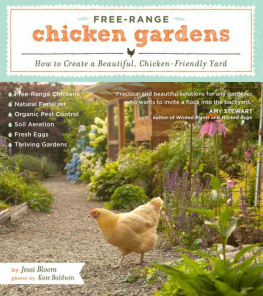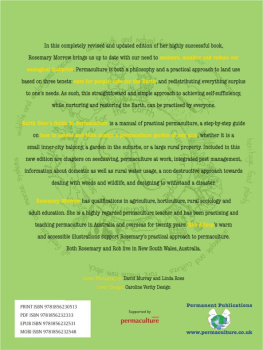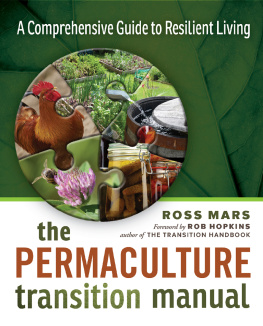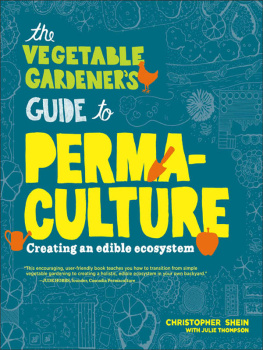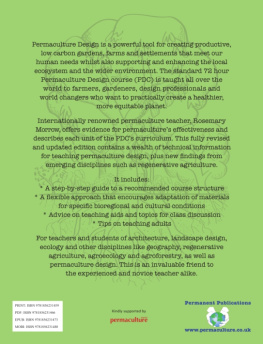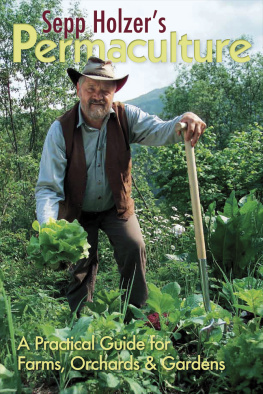
Ecological landscapes can produce many environmental functions as well as beautiful human habitat.
PRACTICAL
PERMA
CULTURE
FOR HOME LANDSCAPES, YOUR COMMUNITY, AND THE WHOLE EARTH
Jessi Bloom & Dave Boehnlein
With illustrations by Paul Kearsley

We dedicate this book to our mothers, who nurtured and supported our growth, and to the Bullock family, whose work inspired change in our lives.

Sweet potato vines can grow as ground cover, yielding delicious edible tubers.
Contents
Preface

Each reader may come to this book on a different path, but we all have something in common: were human, in this together, and we belong to the intricate web of life that Chief Seattle describes. We are all born into that connection and are hardwired to feel it, but depending on our experience in life, we may be pulled away from it. Humans are inherently always looking for a better quality of lifefor health, happiness, comfort, and financial stability, among other things. However, it is easy to look ahead and see that many of the choices we as a species have made in that quest are not going to sustain us.
We are at a crossroads and need to start making changes. Many of us rely on systems that are beyond our controlthe industrial food system, municipal waste and water systems, the energy grid, to name a few. But we dont have to rely on those systemswe can be more self-sufficient and take back the reins. We can remember that human life has an ecological purpose and function, which we, the authors, hope this book will raise awareness of.
We authors, Jessi and Dave, have similar stories. In the 1980s we were growing up on opposite ends of the country, spending our time in natures playground. Tromping through forests, building forts, and damming small streams was a part of our daily lives. We both explored the outdoors through hiking, fishing, camping, and swimming in natural bodies of water, and we both developed deep emotional connections to the land we grew up on. Little did we know in our youth we were second-growth permaculturists in the making. At similar times in our lives, we both witnessed our childhood stomping grounds getting bulldozed in the name of development and were completely distraught. We went on to pursue different studies and careers related to the environment. Jessis passion was dedicated to ecological design, while Dave devoted his career to outdoor education. However, both of us ended up making permaculture not only our profession but also the basis of our lifestyles.
We first crossed paths in 2010 at the Northwest Flower and Garden Show in Seattle. Dave was on the hunt for professionals with whom he could collaborate and looking to create a network of permaculturists who were in the field doing good work. That year at the show, Jessi had designed and built an urban permaculture demonstration garden that won numerous awards for sustainability and aesthetics. The irony is that the word permaculture was so misunderstood that it was taken out of the name of that garden because show managers didnt want to confuse the public. Since that initial meeting, we have collaborated on many projects including designs, workshops, trampoline sessions, and now this book.
Our intention is to make permaculture approachable and inspirational. We want to empower you to start making positive changes, now. We promise that the way you experience the world around you will be richer because of your increased understanding of and participation in nature. At some point, as your connection to the natural world strengthens, you will feel a tap on the shoulder and Mother Nature will say, Youre working for me now. Have you gotten the call yet? If not, get ready for a wild ride.
We have written this book for a wide range of readers. We cover a huge range of climate types as well as scopes and sizes of land. We want people in rural areas as well as urban folks to be able to use this book. The first section, Permaculture Basics, equips you with basic information about permaculture, from the definition to the guiding ethics and principles behind it. This part also outlines basic earth science youll need to know before jumping into the design process. The second section of the book walks you through the entire design process, from observation to analysis and assessment to developing a master plan and planning how to implement the design and maintain what you have created. The third section of the book covers the systems that should be included in any permaculture design: systems for managing soil fertility, water, waste, energy, shelter, food production, and animals and wildlife. The fourth section describes fifty rock-star plants for permaculture landscapes. The fifth section focuses on invisible structures, the economic and social underpinnings of any permaculture design. At the back of the book are lists of resources and suggestions for further reading that we highly recommend you take advantage of, since this book is just a starting point.
Humankind has not woven the web of life. We are but one thread within it. Whatever we do to the web, we do to ourselves. All things are bound together. All things connect.
CHIEF SEATTLE
PERMACULTURE BASICS

Permaculture is a term first coined by Bill Mollison and David Holmgren in the mid-1970s. It has been defined in a huge variety of ways, with the most common being a contraction of the words permanent and culture. Its also been defined as extreme organic gardening and as a lifestyle that includes being barefoot and spiritual, doing circle dances and full-time yoga. Permaculture can certainly include these elements, but its not defined by them. So what, exactly, is permaculture?
In a sense, permaculture is a way of life thats ahead of its time while also taking us back to how our ancestors lived, sustainably and within their ecological means. That doesnt mean we cant live in comfort and utilize current technology in a permaculture lifestyle. Permaculture gives us the tools and techniques to live sustainably while still having our needs met in a lifestyle rich with healthy food, comfortable housing, and renewable energy and resources.
Permaculture is similar to both architecture and engineering in that it is a design approach first and foremost. Whether we are designing a house, a chicken coop, a garden, a bowling alley, or a schoolyard, permaculture is a process that starts with a problem and finds solutions. In permaculture, design decisions are first based on ethics and then incorporate the logic of natural systems. Mimicking natures patterns makes our lives more sustainable and less reliant on resources outside of our control.
In contrast to living in a wasteful, consumerist manner that depletes our resources and doesnt leave future generations much to work with, permaculture is about building resilience and using only what we need and what we have access toin other words, living within our ecological means. Its about building fertility and abundance. Its about designing and building systems in our lives that work together to provide food and water and energy, that reuse waste, and that make life easier. Its about making these systems beautiful and inspiring, and by doing that, making our lives healthier and better overall.
Next page

